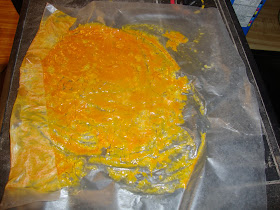I used a half pound of each and averaged the SAP value to 195.8. For one pound of fat I needed .1958 lbs. of lye. But since I used Sodium Hydroxide (NaOH), I had to multiply by the fraction 40/56.1 to get a proper conversion. Finally, to make the soap milder and less caustic to naturally acidic human skin I discounted the lye by another 15.5% to come up with a final number of .1179lbs. or 53.47 grams.
While this seems a bit complicated, it's pretty cool. Once you know the SAP values of various fats and oils you can concoct you own mixtures. This time I tried a relatively simple 50% bison/50% lard mixture, but in the future I could throw in olive oil or another type of oil. Each fat and oil has different properties that can affect the hardness, amount of lather and other characteristics of the finished product.
In this picture I weighed half a pound of beef tallow.

I mixed the beef tallow and pork lard together in a pan over low heat. I then added the grams of lye crystals to water. The lye and water reacted and heated up to around 120 degrees with no outside heat required. I monitored both pots and once they were both around 95 degrees I poured the lye into the fat mixture.

After combining them I stirred the mixture for about 25 minutes. Almost right away the mixture smelled like soap.

After 25 minutes the mixture thickened up. I added purple dye and lavender scent and mixed it together. It actually took a fourth of the bottle to change the color very much.

Finally, I poured it into a rusty cupcake tin which I dedicated to soap making.

Here the soap will sit for a couple days to harden up. After that I will pop them out of the tin and let them cure for a couple weeks before using them. My hope is that using lard will make the bars softer and perhaps lather better than the 100% bison mixture.
The recipe I used was:
1/2 lb. bison tallow
1/2 lb. pork lard
53.47 grams lye crystals
enough water to dissolve the lye.
dye and scent to taste.
I read online that lye crystals are no longer sold in stores because they have been used to make illegal drugs. If this is true then I will eventually run out of a critical ingredient in soap. This gives me more motivation to harvest my own lye using wood ash. I hope to experiment with that in the future.


